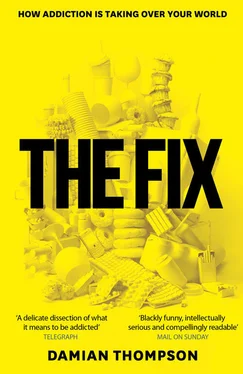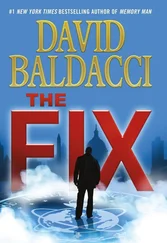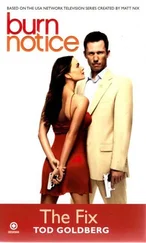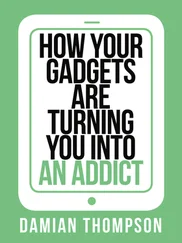Does that mean that the people around me are turning into addicts? That’s never an easy question to answer, because ‘addict’ is such a loaded term. It’s a good word to describe people whose problems are obviously out of control, as mine were, but it has to be used carefully. Not only does it carry misleading overtones of disease, but it also implies that there’s a clear dividing line between ‘addicts’ and ‘non-addicts’. That’s not true. In my experience, addiction is something that people do – to themselves and other people – rather than something that just happens to them; it’s not like developing cancer.
Addiction is easier to understand as a concept if we focus on clearly observable behaviour – that is, the search for a fix and its consequences. Almost anyone can indulge in addictive behaviour, but some of us are more prone to it than others, for reasons that scientists don’t fully understand.
In fact, let’s get this point out of the way right at the beginning of this book. In the past couple of decades, countless scientific studies have attempted to pinpoint what it is about either the brains or the upbringings of addicts that leads them to adopt self-destructive lifestyles. They have failed to do so.
No one is immune from developing addictive behaviour. If there’s a history of addiction in your family, you’re more at risk. Likewise, if you have an impulsive personality – that is, score highly for ‘impulsivity’ in psychological tests – you’re more likely to do something impulsive, such as try a new drug or drink that fatal last glass of whisky before jumping into your car. Indeed, a fashionable term for various addictions is ‘impulse control disorders’. 3 Конец ознакомительного фрагмента. Текст предоставлен ООО «ЛитРес». Прочитайте эту книгу целиком, купив полную легальную версию на ЛитРес. Безопасно оплатить книгу можно банковской картой Visa, MasterCard, Maestro, со счета мобильного телефона, с платежного терминала, в салоне МТС или Связной, через PayPal, WebMoney, Яндекс.Деньги, QIWI Кошелек, бонусными картами или другим удобным Вам способом.
For me these findings fall into the ‘No shit, Sherlock’ category of scientific discoveries. They tell us nothing very surprising. The consensus at the moment is that addiction seems to be the product of genetic inheritance and environment. In other words, the nature versus nurture question is no closer to being settled in this area of human biology than it is in any other. To repeat: we’re all at risk. That’s why the contents of this book apply to everyone, not just coke-snorting hedge fund managers, bulimic receptionists and absent fathers glued to World of Warcraft.
Psychologists talk about addictive behaviours in the plural, recognising the many different impulses that tempt people. What these behaviours tend to have in common is the replacement of people by things and events. We all develop these habits to a certain degree; the people we call addicts are those people who can’t or won’t give them up even when they cause harm to themselves and others. Again, that’s a loose definition, fuzzy at the edges. Never mind; addiction isn’t an easy phenomenon to pin down.
This isn’t to deny that addictive behaviour has important consequences for the brain. It does. Indeed, it can partly be explained by the overstimulation of the brain’s fearsomely complex reward circuitry.
Different parts of the human brain govern what some scientists call the Stop and Go impulses. More primitive sections of the brain – parts that we share with other animals – tell us to consume as much as possible in order to increase our chances of survival. They say: Go. More highly developed parts of the brain, capable of reasoning and not found in other animals, hold up a Stop sign when we’re consuming too much of something for our own good. Classic addicts keep ignoring the Stop instruction, despite the high cost to themselves and others. They require instant gratification, whatever the consequences. Indeed, they’ll often seize any opportunity to indulge in addictive behaviour even when there’s no real gratification to be extracted from it. We’ll discuss this puzzling paradox later.
The Stop and Go imagery helps us understand the growing appeal of the fix. As technologies develop and converge, the speed of delivery increases. So does the speed of our expectations. We now live in a world filled with life-enhancing objects and substances that promise ever faster and more effective gratification. It’s as if everything that tumbles off a production line is stamped with the word Go.
Temptation peeks out at us from the strangest places. Who would have guessed, 40 years ago, that a piece of electronic office equipment – the personal computer – would morph into something so desirable that people would sacrifice huge chunks of their spare time (and income) in order to play with it? Or that modifications to a telephone would generate global excitement?
Changes to our appetites don’t come about by accident. The manager of your local Starbucks didn’t wake up one morning and think: ‘I know what would brighten up my customers’ afternoons – an ice-blended cappuccino!’ As we’ll see, the Frappuccino was invented when Starbucks employed food technology to solve a specific business challenge. As a result, hundreds of thousands of their customers (including me) developed a near-obsessive relationship with something they had previously lived happily without.
The pace of technological change means we need to revise our concept of addiction. Our cultural history provides us with images of stereotypical addicts, some of them dating back centuries: the grinning harridan dropping her baby down a staircase in Hogarth’s Gin Lane; the American Indians crazed with ‘firewater’; the hollow-eyed Chinese sailor propped against the wall of an opium den; the junkie shivering in an alleyway surrounded by needles. Also, anyone who lives in a city is used to the sight of spectacular drunks and morbidly obese people whose addictions are so grotesquely out of control that we avert our eyes.
These are powerful images, but if we pay too much attention to them then we can end up with a dangerous sense of immunity. We overlook our own eagerness to self-administer fixes, those sensory experiences that temporarily lift the mood while subtly detaching us from traditional human relationships. The fix can take any number of forms. Some toy very obviously with the chemistry of the brain. Anyone with a rolled banknote up their nose knows that – so long as their dealer hasn’t ripped them off – they’re about to experience the effects of a mind-altering substance. The same goes for the guy swigging from a whisky bottle. In contrast, the tubby young man who demolishes a packet of chocolate digestives while watching the football doesn’t suspect that his eating habits have left his brain unusually sensitive to stimulation by sugar; he just knows that, once the packet’s opened, the biscuits disappear. His habit of stuffing his face with refined sugar and vegetable fat doesn’t place him very far along the addictive spectrum – but, then again, it may be enough to put him in intensive care when he has a heart attack at 50.
The most puzzling addictions are those that don’t involve the consumption of any substance. Gambling is the obvious example – we’ve known for hundreds of years that it can tear apart families as ruthlessly as hard liquor. In academic circles, these non-substance addictions are known as ‘process addictions’. It’s now clear that things you don’t eat, drink, smoke or inject can nevertheless disturb your brain in much the same way as drugs. And, in an age when so much digital entertainment – notably video games and online pornography – is designed to be as addictive as possible, their potential to do this is accelerating rapidly.
Читать дальше












